A Trip to the Killing Fields of Cambodia
published in: Süddeutsche Zeitung, July 2010
One of the latest stories from Cambodia goes like this: Nhem En was recruited at the age of ten by the Khmer Rouge, and worked his way up in Pol Pot’s regime to become the right-hand man of Duch, the commandant of the S-21 death camp in Phnom Penh. More than twelve thousand people were tortured and murdered there, including a boy who confessed to belonging to the “CIA” because he thought that “CIA” meant “enough food.” Nhem was the photographer of the victims, he fastidiously recorded the events in the camp. In 1979, together with Pol Pot, he fled to Thailand to escape Vietnamese troops, and not until 1997, at the very last minute, did he take advantage of the government’s amnesty program. Today he is a vice governor in the north of the country. In this role, he attempted to sell one of Son Sen’s bones to the journalist Erich Follath. Son Sen, the last former ally to be murdered on Pol Pot’s orders, died in 1998. The price for this exclusive souvenir was standard for Cambodia: one US dollar. Follath rejected the offer.
But Nhem stands to fare better with the Pol Pot memorial that he plans to build in Anlong Veng, the last refuge of the terrorists. He intends to “make the best of the situation and attract tourists” with a museum of reconciliation. He was happy to offer information about his duties in the S-21 to the German TV station ARD, which reported that he even spoke of his past with “a hint of pride.”
It’s hard to imagine a more deeply skewed perspective. What’s worse, Nhem En is by no means an exception; he’s the norm. For a fee of three hundred dollars, one of the murdering stooges from the S-21 will pose for TV crews in Choeung Ek, the killing fields just outside the city gates. Victims were brought here after being tortured, and the man shows the camera how he clubbed them with an iron bar as they knelt beside the ditch, because bullets were too expensive.
But even everyday life in Cambodia holds disconcerting surprises for a traveler: for example, the way the travel guides in Angkor Wat joke about the bullet holes in the relief on the south side of the main temple, which depicts the penalties for liars, thieves, and others in the Khmer Empire six hundred or a thousand years ago. The guides might mention, as an aside, that these punishments aren’t so different from those used in the S-21. But a traveler hoping for a somber note to accompany this declaration will be disappointed: the tone, the gestures, the facial expressions are all better suited to entertainment news. Any sense of sympathy is absent. This horror is for sale. So the guides on bus trips speak for hours into their microphones about Pol Pot’s people and massacres, as if they were talking about last week’s flea market. And the art experts in the national museum in Phnom Penh who hustle visitors through the exhibits, speaking to them in an indecipherable English, are disinterested, too. They respond to comments about the lack of important discoveries here or in the temple complex with a smile, or at best with a sort of outrage feigned for the visitors: “War time!” As if the children from next door had just stolen some candy. Anyone who still clings to the faith that mankind has an autonomous, internal sense of right and wrong can lay this belief to rest in Cambodia.
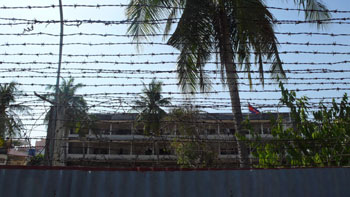
Exterior view of the S-21
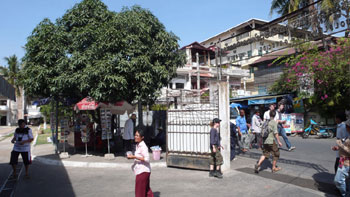
The entrance to the S-21 from inside: at left, stands selling drinks and souvenirs
Estimates of the total number of Pol Pot’s victims vary somewhat. In less than four years, roughly one in four Cambodians was killed. For a number of reasons, the term “autogenocide,” which has unfortunately entered into standard usage, does not prove particularly helpful either in itself or as a means of comparison to other atrocities (always a precarious exercise). Perhaps there’s room to argue about when the country was destabilized: as early as 1863, when French colonizers arrived and calculatingly placed the “more reliable” Vietnamese in administrative positions? Or not until 1940, when the German occupation of Paris triggered an immediate invasion by Japanese and Thai troops? In any case, the final blow certainly came from the American bombardments, which extended the reach of the war from neighboring Vietnam without a formal declaration, easily surpassing in density anything the world had ever seen. They were the beginning of the rise to power of Pol Pot, aka Saloth Sar, a failure as a student in Paris who later became a country school teacher. That’s not all: because he was deposed by Vietnamese loyal to Moscow, he kept a seat at the UN until 1991, at the behest of the USA and China. From a woven mat in a wooden shed in Thailand, he directed his diplomats through a Manhattan he had never seen, and guided his terror troops through the northern regions of his country, all in his legendary soft voice which can be heard in recordings online. Time after time, those troops won land and lost it again.
Violence can become a social norm, as Wolfgang Sofsky argues. According to the institutions that handle adoption, Cambodian children never cry.
That’s nothing new for us. From August 1949 to March 1950, Hannah Arendt traveled through her native country, and she recounts that Germans sent each other postcards of churches and marketplaces that no longer existed. “And the indifference,” writes Arendt, “with which they walk through the rubble has its exact counterpart in the absence of mourning for the dead, or in the apathy with which they react, or rather fail to react, to the fate of the refugees in their midst. It is as though the Germans, denied the power to rule the world, had fallen in love with impotence as such.”
Traces of this impotence can be seen in the contemporary debates about German foreign policy. Psychologically, we are confronted with the phenomenon of dissociation, which powerfully counteracts our ability to experience and remember the catastrophe. This is what makes it possible to continue living at all. Alexander Kluge and W.G. Sebald have drawn attention to the gaps in accounts of the war. These gaps in memory and perception naturally continue to produce new gaps in our consciousness and ability to act, on all sides: “The position of an anti-Nazi,” Arendt continues, “resembled that of a normal person who happens to be thrown into an insane asylum where all the inmates have exactly the same delusion: it becomes difficult under such circumstances to trust one’s own senses.”
For the victims in Cambodia, the situation must be much the same today with respect to Nhem En and his former colleagues. Except that most people there are victims and perpetrators at the same time, making it difficult to differentiate. Nhem En’s colleagues are in every village and every family. Thus impotence develops unnoticed to become a national survival strategy. This may explain the strange experiences that await and frustrate visitors to the S-21 or the killing fields, even in 2010.
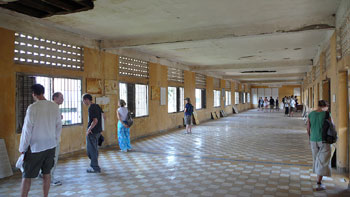
One of the main halls of the S-21 in 2010: holes several feet in diameter in the ceiling, many exhibits have been damaged by rain and fallen from the walls
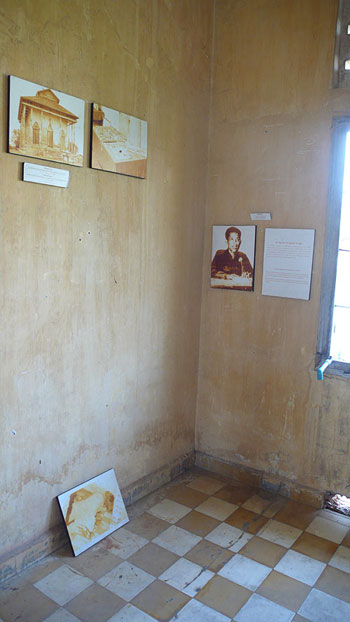
Photo of an unnamed victim on the floor; right, photo and biography of the torture chief Duch
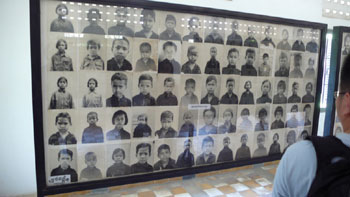
Photographs of the victims taken by Nhem En, only children are shown here
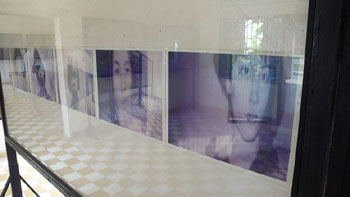
Stefan V. Jensen’s photographic work about the gallery of victims of the S-21
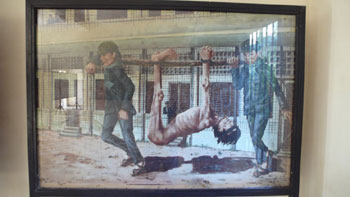
Depiction of an everyday scene in the camp by Vann Nath, a painter who survived the camp and now runs a café in Phnom Penh
Although the S-21, originally built as a school named Tuol Sleng after the bitter fruit of a tree, was transformed into a memorial shortly after Pol Pot fled the country, today it lacks any sense of dignity. Bored employees sell tickets and then press tourists to buy brochures or hire a guide, once again with limited English skills. They use the inner courtyard for parking and smoke breaks. Soon we’re standing in a torture cell with no barriers to protect it from the visitors who pick up and put down the instruments that were once used to kill. The ceiling directly above us shows spots of blood. On the fourth floor, there are holes several feet in diameter in the roof, and in the summer rain comes in everywhere. You can see where the water has run over the exhibits. Many of the displays have fallen from the walls and lie on the ground. In one corner is a proper portrait of the torture chief Duch, accompanied by a brief biography. Beneath it, a picture of an unnamed victim lies on the floor – without any commentary.
Visitors only learn the most important dates of the revolution, information is not presented systematically. Pol Pot’s pathology, which developed to its fullest extent here on this spot, does not even begin to become clear. For instance, most of those murdered in the S-21 weren’t opponents of the regime, but rather members of the communist party. And most of the torturers in the S-21 eventually found themselves on the other end of the process. They had to confess their own failings, admitting perhaps that they had not interviewed their prisoners harshly enough, or had killed traitors too quickly, always in order to hurt the regime. Then they themselves were put to death, as well-researched books of David Chandler and others attest. Only seven people survived.
One of the upper floors of the S-21 is completely devoted to the visit of Swedish intellectuals accompanying Gunnar Bergström, who like so many others still supported the revolution in 1978. As ludicrous as it was, the visit was inconsequential in view of larger world political circumstances not discussed here. Finally, at the end of a four-hour tour, one arrives at the disturbing photographs by an unknown European artist, Stefan V. Jensen, which have been hanging on that spot for six years. Jensen re-photographed the images of the victims taken by Nhem En. According to the artist, this doubling is meant to depict souls deprived of release: for if a Buddhist is not buried within seven days in accordance with customs, he can never arrive in his next life. He must wander forever as a spirit between the worlds. Jensen’s banal photographic representation seems ambitious at best when viewed next to the painful representational paintings by the survivor Vann Nath; in fact, they are heartless. Apparently the museum is proud just to display the work of a Western artist. Art in the memorial: no problem. The quality doesn’t matter.
Finally, at the end of the tour – still inside the death camp – the visitor arrives at a shop selling watches, assorted DVDs, and t-shirts, where a garishly made-up American woman is haggling over the price of postcards that depict the riverside of Phnom Penh, quaint cafés at the mouth of the Mekong. And at the gate the rickshaw drivers immediately pounce: “Killing fields,” they shout in our faces, “killing fields, killing fields. Ten dollar. Tomorrow killing fields. Tomorrow. Ten dollar.”

Grotesque sights: Many tourists choose to be photographed in front of this collection of skulls.
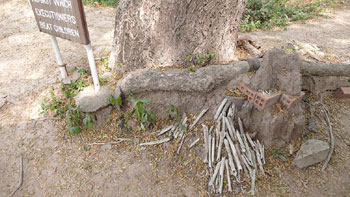
The tree on which children were beaten to death. In front, recently discovered teeth and bones.
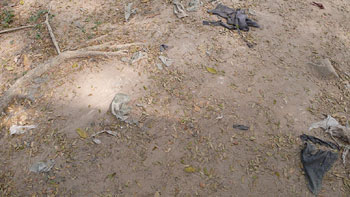
In the section of the memorial open to tourists: scraps of clothing half buried in the ground; a bone, apparently a femur, lies exposed under the tree roots.
What Robert D. Kaplan saw there in 1996 and described as ignorant tourism is evident to us in exaggerated form the next day. In front of a tower where the skulls of hundreds of murdered victims are displayed, a Japanese couple smiles and says “cheese” for a photo – taken by an employee of the memorial, also smiling. The clueless tourist snaps a few more pictures of himself right next to the tower, holding the camera at arm’s length, the skulls at eye level giving his grimaces a heroic quality.
We quickly turn away and proceed along the various stations of the small compound. Small signs provide information: here the prisoners were unloaded, here their identities were confirmed, then they were immediately led to the ditch and executed. At the ditches that have been excavated, a sign warns tourists not to walk on the mass graves. A strange idea, I think, but I am surprised by the pieces of clothing lying around. Two or three are half buried in the ground. Then we are standing in front of the tree on which children were beaten to death, some bones and teeth lie there in strange rows as they were found. Under my shoe I discover a bone in the ground, it appears to be a femur.
“In the rainy season,” a young museum guide explains to me a few minutes later, “they come to the surface.” He looks at me as he explains, “We haven’t been able to clear them all out yet.” And the display boards confirm this: Two thirds of the mass graves are outside of the area accessible to tourists. They remain untouched even today.
There isn’t a religious reason for this neglect. It’s one more indication of impotence. In 1950 Hannah Arendt wrote about Germany, “The younger generation seems to be petrified, inarticulate, incapable of consistent thought.”
This has been confirmed in recent years by intensified research about the impact of war-related trauma on subsequent generations. This remains a new area of interdisciplinary research. Roughly speaking, however, the impression created is that there are only two ways to actively engage with past: affirmation, which appears natural to Nhem En, or outright refusal. The latter was represented by the student protests in Germany, which counted a new form of terrorism among their consequences. The cause is evident: in the center, where civility and citizenship ought to be anchored, is the catastrophe that prevents all access to the world. This is the explanation for the third and most common response: turning away, wishing for ignorance, the lack of interest shown by survivors in the new reality and everyday concerns that confront them and their children. It is a sort of inner death, as Lizzie Doron has exemplarily demonstrated for survivors of the Holocaust. In many cases, it involves an exchange of roles between parents and children, in which younger family members are forced to take over responsibility for their elders too soon, and the effects extend over many generations. Perhaps the debate initiated in Germany by Michael Winterhoff about the abolition of childhood could also be understood in this context. The sense of homelessness of those born after, which has been described so often in Germany, certainly comes as no surprise. But it impedes any effort to formulate positive goals, as Sebald said, “such as the realization of democracy.”
That is why therapy is so important, even if so far its availability in Cambodia has generally been limited to small groups, and offered by foreigners such as the German psychologist Judith Strasser. Strasser has conducted funeral services with the families of victims in Choeung Ek, and has assisted them during the trial of the torture chief Duch. He, at least has proven to be an exception: he expressed regret and begged for forgiveness. Whether or not he receives it, and even though he ultimately pled “innocent,” it was at least a small light in the midst of Cambodia’s miserably long catastrophe. This month, Duch was sentenced to 35 years in prison.
Copyright Text & photos by Ralf Bönt
English by Kurt Beals

